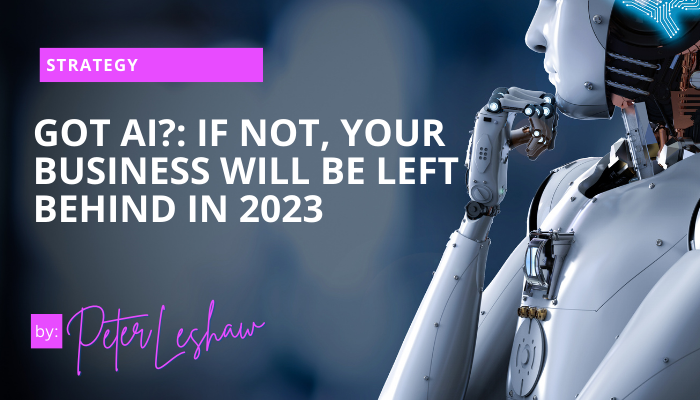
Artificial intelligence (AI) has rapidly become one of the most transformative technologies of our time. It is changing the way businesses operate and revolutionizing industries such as healthcare, finance, and retail. In this article, we’ll explore the importance of AI adoption and the potential consequences of not implementing it. We’ll also provide an overview of AI, its benefits and challenges, and provide guidance on how businesses can get started with AI adoption.
Understanding AI
AI refers to the simulation of human intelligence in machines that can perform tasks that typically require human intelligence, such as visual perception, speech recognition, decision-making, and language translation. There are two main types of AI: narrow AI, which is designed to perform specific tasks, and general AI, which can perform any intellectual task that a human can.
AI’s capabilities include pattern recognition, natural language processing, and predictive analytics. However, it also has limitations, such as the inability to empathize, make moral judgments, or understand context.
AI is already being used in various industries to improve efficiency and productivity. For example, banks use AI to detect fraudulent transactions, while healthcare providers use it to diagnose diseases. AI is also used in manufacturing to optimize supply chains and in customer service to provide personalized experiences.
Benefits of AI Adoption
AI adoption offers several benefits to businesses, including improved efficiency, better decision-making, enhanced customer experiences, and increased revenue.
By automating routine tasks, AI can improve efficiency and productivity. For example, it can help reduce human error, improve operational workflows, and increase output.
AI can also improve decision-making by analyzing data in real-time and providing insights to support decision-making. This can help businesses make more informed decisions, reduce risk, and identify opportunities for growth.
Enhanced customer experiences can be achieved with AI by providing personalized recommendations and proactive service. For example, AI-powered chatbots can offer 24/7 customer service and address customer queries in real-time.
Finally, AI can increase revenue by identifying new revenue streams, optimizing pricing strategies, and improving customer retention rates.
Challenges of AI Adoption
Despite the benefits of AI adoption, there are also challenges that businesses must consider. These include high implementation costs, potential job displacement, ethical concerns, and data privacy and security risks.
The high costs of AI adoption can be a barrier for some businesses, particularly small and medium-sized enterprises. Additionally, AI adoption may result in job displacement, which can create challenges for businesses and employees.
Ethical concerns associated with AI adoption include bias, privacy, and transparency. For example, AI algorithms may produce biased results if the data used to train them is biased. Additionally, AI may raise privacy concerns if it collects and analyzes personal data without consent.
Data privacy and security risks are also a concern with AI adoption. If AI systems are not designed with security in mind, they can be vulnerable to cyberattacks and data breaches.
Getting Started with AI Adoption
To get started with AI adoption, businesses must identify the needs that can be addressed with AI, assess data readiness, select the right AI solution provider, build an AI team, and follow best practices for AI adoption.
Identifying the needs that can be addressed with AI involves analyzing the business processes and identifying areas that could benefit from automation or improved decision-making.
Data readiness is crucial for successful AI adoption. It involves assessing the quality and quantity of data available for training and validating AI models.
Selecting the right AI solution provider is also essential. Businesses need to evaluate the provider’s expertise, experience, and reputation.
Building an AI team involves hiring professionals with the necessary skills, such as data scientists, machine learning engineers, and AI developers. It is essential to have a team with diverse skills and backgrounds to ensure a successful
AI implementation
Finally, following best practices for AI adoption involves creating a roadmap, testing AI models, monitoring performance, and iterating as needed. It also involves ensuring that the AI solutions comply with ethical standards and data privacy regulations.
Conclusion
AI adoption offers significant benefits to businesses, including improved efficiency, better decision-making, enhanced customer experiences, and increased revenue. However, businesses must also consider the challenges associated with AI adoption, such as high implementation costs, potential job displacement, ethical concerns, and data privacy and security risks.
To get started with AI adoption, businesses need to identify the needs that can be addressed with AI, assess data readiness, select the right AI solution provider, build an AI team, and follow best practices for AI adoption.
Don’t get left behind in the AI revolution. Start your AI adoption journey today and gain a competitive advantage in your industry.
Ready to take your business to the next level with AI?
Contact Peter Leshaw today for expert guidance and support in implementing AI into your business practices. Don’t get left behind in the AI revolution – let Peter help you harness the power of AI for enhanced efficiency, better decision-making, and increased revenue. Contact Peter now to schedule a consultation.
FAQs: Artificial Intelligence (Ai)
What is the difference between AI and machine learning?
AI refers to the simulation of human intelligence in machines that can perform tasks that typically require human intelligence. Machine learning is a type of AI that involves training algorithms to learn from data and make predictions or decisions.
How does deep learning work?
Deep learning is a type of machine learning that involves training artificial neural networks to recognize patterns in data. It uses multiple layers of interconnected nodes to learn increasingly complex features of the data.
What is natural language processing, and how does it work?
Natural language processing (NLP) is a branch of AI that involves teaching machines to understand and interpret human language. It involves tasks such as speech recognition, language translation, and sentiment analysis. NLP works by using machine learning algorithms to analyze language data and identify patterns and relationships between words and phrases.
What types of tasks can AI be used for?
AI can be used for a wide range of tasks, including image and speech recognition, decision-making, predictive analytics, and natural language processing.
What are some examples of companies that have successfully implemented AI?
Many companies have successfully implemented AI, including Amazon, Google, Microsoft, and IBM. For example, Amazon uses AI for personalized product recommendations, while Google uses AI for natural language processing and search optimization.
How can AI improve decision-making?
AI can improve decision-making by analyzing data in real-time and providing insights to support decision-making. This can help businesses make more informed decisions, reduce risk, and identify opportunities for growth.
What are some strategies for minimizing job displacement due to AI adoption?
Strategies for minimizing job displacement due to AI adoption include retraining employees for new roles, investing in education and training programs, and offering incentives for employees who learn new skills.
What ethical concerns are associated with AI?
Ethical concerns associated with AI include bias, privacy, and transparency. For example, AI algorithms may produce biased results if the data used to train them is biased. Additionally, AI may raise privacy concerns if it collects and analyzes personal data without consent.
How can companies ensure data privacy and security when using AI?
Companies can ensure data privacy and security when using AI by designing AI systems with security in mind, encrypting sensitive data, and implementing access controls and authentication measures. They should also comply with data privacy regulations, such as GDPR and CCPA.
How can I get started with AI adoption on a small scale?
To get started with AI adoption on a small scale, businesses can begin by identifying a specific use case and experimenting with different AI tools and platforms. This can help them gain experience and develop the necessary skills and infrastructure for larger AI projects.
What are some common misconceptions about AI?
Common misconceptions about AI include the belief that AI will replace humans or that AI is infallible. However, AI is not a substitute for human intelligence, and it is not immune to errors or biases.
How can AI be used for social good?
AI can be used for social good in various ways, such as disaster response, healthcare, and environmental protection. For example, AI can help predict natural disasters, diagnose diseases, and monitor wildlife populations. By harnessing the power of AI for social good, businesses can make a positive impact on society while also advancing their goals.

